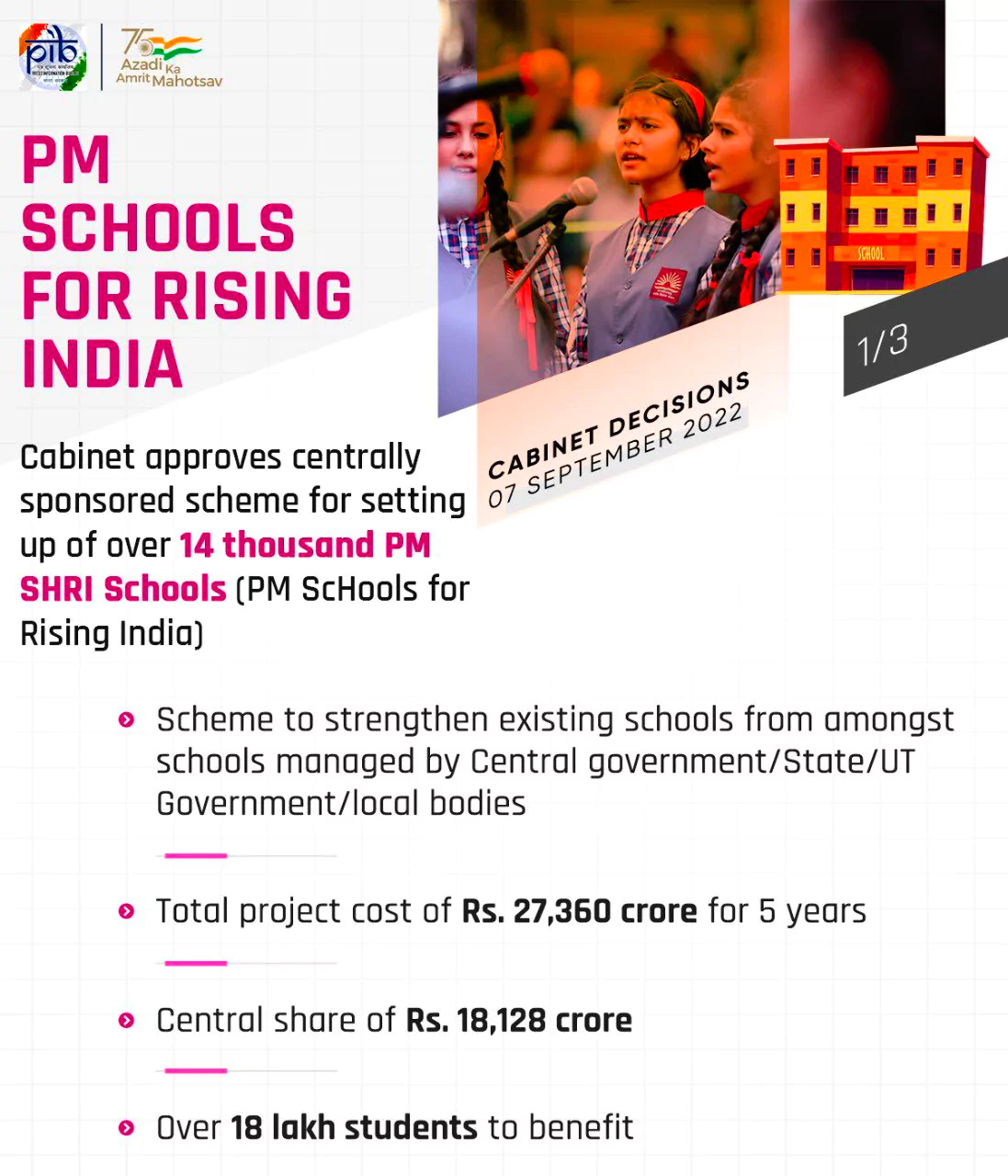Samagra Shiksha funds for the third and fourth quarters of 2023-24 and the first quarter of 2024-25 for Delhi, Punjab and West Bengal have not been released.
- The Centre has stopped funding for the umbrella program for school education in three opposition-ruled states that have refused to implement its PM SHRI scheme.
About PM SHRI Schools (PM Schools for Rising India) Scheme
The Scheme was approved by the Union Cabinet in 2022.
- Aim: This centrally sponsored initiative seeks to develop 14,500 schools to “showcase” the National Education Policy (NEP), 2020, and be “exemplars” for other schools in their region.
 Applicability: The scheme is for existing elementary, secondary, and senior secondary schools run by the central government and state and local governments around the country.
Applicability: The scheme is for existing elementary, secondary, and senior secondary schools run by the central government and state and local governments around the country.- Financial Outlay: The scheme’s total project cost is Rs. 27,360 crore, with a central share of Rs. 18,128 crore over five years (2022-23 to 2026-27).
- Target: States/ UTs have to work to ensure zero dropout rates in all grades within two years of implementation, comply with norms for pupil-teacher ratio, and implement “innovative pedagogy” such as activity-based, sports-based, art-based, and toy-based learning.
- Statistics: The PM SHRI dashboard online currently lists 10,077 schools, of which 839 are Kendriya Vidyalayas and 599 Navodaya Vidyalayas, both run by the Centre. The remaining 8,639 schools are run by state or local governments.
- Top Achievers: UP has the most PM SHRI schools (1,865) followed by Maharashtra (910) and Andhra Pradesh (900).
Enroll now for UPSC Online Course
Features of PM SHRI Schools
The Scheme is Implemented through existing administrative structures for Samagra Shiksha, Kendriya Vidyalayas and Navodaya Vidyalayas and comprises following features.
- Equitable Education:
- Focus on diverse backgrounds, multilingual needs, and varied academic abilities.
- Act as active participants in their learning process as per the vision of NEP 2020.
- Green School Initiatives:
- Incorporate environment-friendly aspects like solar panels, LED lights, nutrition gardens, waste management, and water conservation.
- Create awareness for adopting a sustainable lifestyle.
- Innovative Pedagogy:
- Experiential, holistic, and learner-centred teaching methods.
- Encourage play/toy-based and inquiry-driven learning, fostering 21st-century skills.
- Assessment and Quality Assurance:
- Competency-based assessment at all levels.
- Regular quality evaluations using the School Quality Assessment Framework (SQAF).
- School Quality Assessment and Assurance Framework (SQAAF): A set of standards and best practices as paradigms for attaining individual and institutional excellence.
Selection Methodology for PM SHRI Schools
PM SHRI schools are selected through the “challenge mode” — schools that meet certain minimum benchmarks (including a pucca building in good condition, barrier-free access ramps, at least one toilet each for boys and girls) can apply online.
- Quarterly Application Process: For schools to self-apply on the online portal.
- Parameters for Evaluation: They are evaluated on a set of parameters that include infrastructure, teaching staff, and learning outcomes.
- Inclusion: Schools in urban areas must score at least 70%; those in rural areas 60% to be selected.
- States are supposed to send a list of recommended schools to the Ministry, and an expert committee headed by the School Education and Literacy Secretary draws up the final list.
- Maximum two schools (one Elementary & one Secondary/Senior Secondary) would be selected per block/Urban Local Body with upper limit of number of total schools across India.
- Use of Prefix PM SHRI: The state, UT, or Kendriya Vidyalaya Sangathan/ Navodaya Vidyalaya Samiti is required to sign a Memorandum of Understanding (MoU) with the Ministry of Education committing to implement the provisions of the NEP “in entirety within the entire State/ UT”, and to prefix PM SHRI to the name of the selected school.
- Geo-tagging of Schools: For the selection and monitoring of PM SHRI Schools.
- The services of Bhaskaracharya National Institute for Space Applications and Geo-informatics (BISAG-N) will be taken for geo-tagging and other related tasks.
Check Out UPSC CSE Books From PW Store
Reason for Decline by State Governments to Participate in PM SHRI Scheme
- Delhi and Punjab: These states are already implementing similar schemes for exemplar schools called “Schools of Specialized Excellence” and “Schools of Eminence” respectively.
- West Bengal: Objected to the requirement of prefixing PM SHRI to the names of the schools, especially since the state bears 40% of the cost.
About Samagra Shiksha Scheme
The Samagra Shiksha Scheme supports implementation of the Right of Children to Free and Compulsory Education (RTE) Act, 2009.
- Proposal: It was proposed by the Union Budget of 2018-19, subsumed the erstwhile Sarva Shiksha Abhiyan (SSA), Rashtriya Madhyamik Shiksha Abhiyan (RMSA), and Teacher Education (TE) schemes.
- Funding: The scheme is funded in a 60:40 ratio by the Centre and states, barring the 11 Northeastern and Himalayan states, which have to bear only 10% of the cost.
|
![]() 18 Jul 2024
18 Jul 2024
 Applicability: The scheme is for existing elementary, secondary, and senior secondary schools run by the central government and state and local governments around the country.
Applicability: The scheme is for existing elementary, secondary, and senior secondary schools run by the central government and state and local governments around the country.